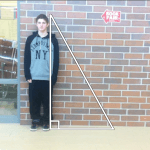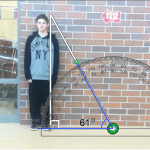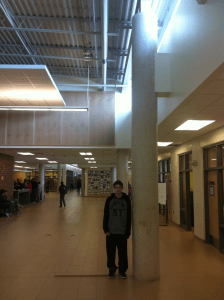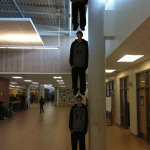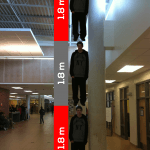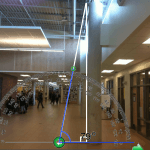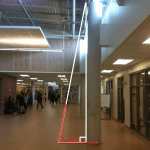Finding Height Given a Side and Angle
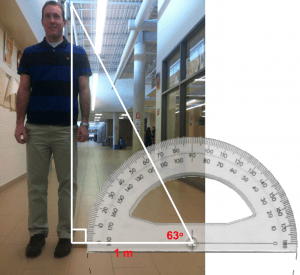
The following lesson provides Real World Math Problems that was created with the Foundations of Mathematics (MFM2P) Grade 10 Applied course in mind. Teachers from Ontario schools as well as schools world-wide are welcome to use this lesson and series of videos in their classroom to engage their students with a real world application using the Primary Trigonometric Ratios (SOH CAH TOA) to find height given a side and an angle. Throughout the lesson, students are asked to determine how tall a student is, to estimate the height of a support pole in the main hallway of Tecumseh Vista Academy K-12 School and then finally, calculate the actual height using prior knowledge from our Similar Triangles and Trigonometry unit.
Success Criteria:
After our Real World Math Trigonometry Lesson, I will be able to:
- analyse a real-world situation and make a connection to the prior knowledge I have learned throughout this math course,
- deconstruct the problem and use prior knowledge of the primary trigonometric ratios acquired throughout this unit to create a solution to the problem,
- and, show adequate steps to clearly demonstrate my understanding.
Minds On:
Students will watch a 30 second video called Real World Math – Trigonometry (1/3) – Using Primary Trig Ratios to Find Height. In the video, Dylan (a student) is standing against a wall with a metre stick on the floor touching his shoe.
Watch the Video:
Question Asked in Video:
How Can We Find Dylan’s Height?
After the video, the teacher can have the students share out ideas regarding how we can go about finding the height of Dylan in the video. Some guiding questions include:
- What information would be useful to help us solve the problem?
- Why do you think the metre stick is on the ground next to Dylan?
- Is the metre stick the only piece of information required to determine a solution?
- Click here to add your guiding question(s) in the comments below!
Photos Providing Additional Information:
- Click on the image to download the full-size file for use in your classroom.
- Click on the image to download the full-size file for use in your classroom.
After the discussion, prompt students to determine Dylan’s height using the method of their choice. Sharing out via Apple TV would be ideal to see if there are any creative solutions other than the Primary Trigonometric Ratios.
Action:
Students will then watch the next 30-second video clip called Real World Math – Trigonometry (2/3) – Estimate the Height of the Support Pole. In the video, Dylan stands next to one of the building support poles in the main hallway at our school, Tecumseh Vista Academy. You can pause the video or use the image to the right to help them engage in a discussion with their table groups.Question Asked in Video:
Estimate the Height of the Support Pole.
Working in table groups, the students can try to come up with they believe to be their best estimates.
Some guiding questions:
- Estimate heights that you believe to be too low, too high and the actual height (Dan Meyer’s 3Acts).
- What are some estimates you can make using the height of objects you know in the picture?
- Click here to add your guiding question(s) in the comments below!
You may find that some groups decide to make random guesses, while others might use objects from the photo as a reference to make their estimates. Encourage groups to make estimates based on any information they can relate to the scenario.
Groups Having Difficulty?
If you find that some table groups are having difficulty, or this is the first time you are attempting a problem outside of your regular routine, you might want to give them some additional guidance.
After discussing student estimates and why they believe their estimate would be close to the real height, you can then show them some more detailed information like the following:
- Click on the image to download the full-size file for use in your classroom.
- Click on the image to download the full-size file for use in your classroom.
Consolidation:
Students will then watch the last 30-second video clip called Real World Math – Trigonometry (3/3) – Find the Height of the Support Pole. In the video, students are provided with a quick view of the supprt pole as well as a triangle with the angle of elevation and length of the adjacent side (the metre stick).
Question Asked in Video:
How Tall is the Support Pole?
Feel free to pause the video to give the required information, or bring up the following images for students to use as they work independently or with an elbow partner:
- Click on the image to download the full-size file for use in your classroom.
- Click on the image to download the full-size file for use in your classroom.
Encourage students to share their results over the Apple TV or by simply explaining from their seat. Using a single iPad as a document camera can also be useful to quickly share student work over a projector or Interactive Whiteboard.
Suitable for the Following Ontario Mathematics Curriculum Courses:
- Grade 10 Mathematics
- MFM2P – Foundations of Mathematics, 10
- MPM2D – Principles of Mathematics, 10
- Grade 11 Mathematics
- MBF3C – Foundations of Mathematics, College Preparation, 11
- MCF3M – Functions and Applications, 11

